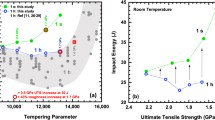Conclusions
-
1.
Plastic deformation after quenching and low-temperature tempering increases the ultimate tensile strength of steel 28Kh3SNMVFA, with retention of satisfactory ductility and fracture toughness.
-
2.
Low-temperature tempering after deformation leads to an additional increase in strength. This effect increases with the degree of deformation.
-
3.
The best combination of properties is obtained by quenching, tempering at 200°, 20% deformation, and tempering at 200°.
-
4.
The high strength of strain martensite is retained with tempering up to 500–550°.
-
5.
The strength of the deformed steel after brief tests at elevated temperatures (up to 500°) is higher than that of the quenched steel.
Similar content being viewed by others
Additional information
Translated from Metallovedenie i Termicheskaya Obrabotka Metallov, No. 9, pp. 26–29, September, 1978.
Rights and permissions
About this article
Cite this article
Vasil'eva, A.G., Komissarova, L.A. & Goryushin, V.V. Resistance of strain-hardened martensite to tempering. Met Sci Heat Treat 20, 718–721 (1978). https://doi.org/10.1007/BF00703750
Issue Date:
DOI: https://doi.org/10.1007/BF00703750




